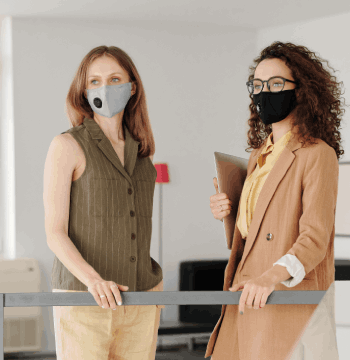Blog
4 Visitor Management Strategies to Transform into a Socially Responsible Organization
- By Karan Singh
24 Nov


The last 18 months of transition has freed the security industry.
The majority is now wise to the fact that processes of visitor management and access control are of paramount importance.
Building committees and business organizations are exploring how they best can create a rounded on-site strategy to manage all manner of human encounters to minimize risk.
There are several software and hardware solutions that make these strategies easier for building managers and business owners—most notably visitor management systems. These solutions allow customization of the visiting experience with the added advantage of data to inform real-time decisions.
Without further ado, we explain the 4 different strategies of using these solutions to ensure safer workplaces, residences, and public buildings for the future.
1. Brisk, Touchless Check-ins
COVID transmission has risen to the top of every mind when discussing the dangers of social mingling and movement through building bottlenecks. And time wasted in reception areas is a long-standing annoyance.
Ideally, there is a simple solution to this: there should be no (or minimal) contact between receptionists, security guards, and visitors, and certainly no paper logbook that demands time-wasting scribbles!
A visitor management system acts as the perfect medium between parties, offering your visitors a quick, seamless sign-in experience that utilizes touchless kiosks and smartphone QR access codes, eliminating queues and crowds. It won’t take a minute—it will take seconds!
And how is all the visitor data managed? From a convenient central dashboard and double-check applications that ensure data security. You can manage multiple locations from one central dashboard and analyze how visitors are populating your premises. It’s a wonderful set of tools!
2. Identification Entails More Known Variables
At any given time, you might know the exact identity of only a fraction of the total number of people walking through your doors. You may not even know why they are coming nor when and if they are leaving.
These are unknown variables that need to be made known.
How do you solve this? Establish a strong check-in progression:
● Incorporate the requirement for photos and other unique visitor identity details into your visitor authentication and management system (VAMS) for first-time visitors.
● You can also have a provision to print visitor badges/passes at check-in for their use while on the premises. To keep it paperless, a “soft pass” with QR code verification also works.
● To go a step further, fingerprint, body temperature, and other biometric systems can also be integrated into a VAMS. If someone has a feverish temperature, you will know.
● Categorize passes, badges, or labels based on the groups of people coming in: interviewees and job applicants, contract laborers, cleaning and maintenance staff, food/package delivery people, and employees can be easily distinguishable based on their passes.
3. Utilize Watchlists to Screen Visitors
How do you disallow access to recurring salesmen, disgruntled ex-employees, and other troublemakers?
A watchlist. A data-rich VAMS allows you to create a list of undesirable visitors which you can later refer to. Later, when the same visitors return, receptionists can run background checks on the internal database (or third-party databases) to swiftly notify security guards of these known variables.
As we mentioned earlier, a VAMS can have one central dashboard for information, and that can be referred to by any number of branches an organization may have. That means any troublemaker put on your watchlist in one location is put on them all! This boosts security across your entire enterprise.
Can you customize the watchlist for other functions? You bet. Watchlists can also be calibrated based on health questionnaire responses in the check-in process on smartphones and PCs. If a visitor’s answers indicate symptoms, they will be placed on a watchlist and denied entry. Your company will also have the log of their filled-in questionnaire for legal purposes, should they arise.
4. Real-time Alerts for Emergencies
What do you do when an emergency emerges out of the blue?
Unpredictable situations are the only predictable forecast in any dynamic, human-populated system like an office or public building. A well-calibrated VAMS can have automatic notifications sent to hosts when a visitor fails the health questionnaire and pre-screening protocol.
Then, there are large critical events, when sending an emergency alert to your entire office could be necessary for their wellbeing. Any unanticipated environmental, political, or health crisis could require action from your security team to ensure the safety of everyone possibly involved. Response times always matter in times of emergency. A VAMS can send instant alerts, instructions, and health information to those in danger.
With these 4 socially responsible strategies, a business organization or public building can pacify their returning employees, enabling them to gain trust in the process. As time goes by, the protocols put in place will ensure a safer environment that will endure. VAMS Global is one such visitor management system supplier that can aid in your strategies to win back trust in the workplace.

Subscribe to our Newsletter
HEAD OFFICE
VAMS Safeguard Pvt. Ltd.
+91 22-4170-7575 [email protected]C-209/210, Mittal Commercia Premises Co. Op. Soc. Ltd., Near Mittal Estate, Andheri East, Mumbai – 400059
HEAD OFFICE
Suite 1902, 1212, Avenue Of the Americas, New York, NY 10036
© 2025 by VAMS GLOBAL.






